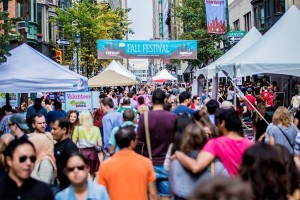Why David Bowie Never Listened to Tower Theater-Recorded David Live
David Bowie once released an album so bad Bowie himself never listened to it.
Of course it was recorded in the area. The material for David Live, Bowie’s first live album, was recorded at the Tower Theater during Bowie’s six-night stint there in July 1974. Bowie was on his Diamond Dogs Tour, an elaborate stage show that included a bridge/elevator that went 25 feet in the air.
Bowie recalled in 1990 that the tour “was good fun and dangerous, with the equipment breaking down and the bridges falling apart on stage. I kept getting stuck out over the audience’s heads, on the hydraulic cherry picker, after the finish of ‘Space Oddity.'” The set weighed six tons. It apparently didn’t work, receiving “tepid-to-negative reviews.”
The live album fared worse, if possible. Recorded during the Upper Darby shows, it had an inauspicious beginning. According to some reports, Bowie’s band revolted against manager Tony DeFries before the show after learning they wouldn’t be paid extra for the live double-LP recording: “On the basis of the likely sales of the album they calculated they were entitled to $50,000 ($5,000 each).” Bowie agreed to pay them, and they went on.
Things still didn’t turn out so well. Bowie never listened to David Live, so he had to guess at what it contained. “David Live was the final death of Ziggy [Stardust],” he told Melody Maker in 1977. “God, that album. I’ve never played it. The tension it must contain must be like a vampire’s teeth coming down on you. And that photo on the cover. My God, it looks like as if I’ve just stepped out of the grave. That’s actually how I felt. That record should have been called David Bowie Is Alive And Well And Living Only In Theory.”
It’s probably a good thing Bowie didn’t listen to it, because the Upper Darby-recorded album was destroyed by critics. Robert Christgau, dean of the rock reviewers, gave it a C-: “The artiste at his laryngeal nadir, mired in bullshit pessimism and arena-rock pandering — and the soul frills just make it worse.” Rolling Stone was similarly harsh: “Rather than serving as a welcome introduction to or summation of David Bowie’s oeuvre, this two-record live album lumps together the several facets of his music into a thin, samey oneness … you figure you’re hearing Bowie on the wrong night.”
No one was harsher, however, than Mick Jagger, who later did “Dancing in the Street” with Bowie as part of the Live Aid effort. He ripped the album’s lead single, an Eddie Floyd cover, too. “I mean, ‘Knock on Wood’ was awful, right,” Jagger said not long after the album was released, “and that David Live … Christ, I mean, if I’d got the kind of reviews that he got for that album, I would honestly never record again. Never.”
Nonetheless, the album went gold. It’s still getting panned, though. “This is truly a miserable live album,” wrote the American Hit Network. “A double record, and it’s a drag,” another review read. “Aside from a couple of intriguing arrangements, the record is limp,” the wonderfully named Exploded Goat website wrote. “David’s coked chanteusery has nowhere to hide.”
But no matter. Bowie went on to better things in Philadelphia, recording Young Americans at Sigma Sound Studios at 212 N 12th Street in Center City later in 1974. The video for “Modern Love” was also filmed at The Spectrum on July 20th, 1983. And it was a 1983 Penn graduate, David Pullman, who came up with the idea for Bowie Bonds.
Follow @dhm on Twitter.


